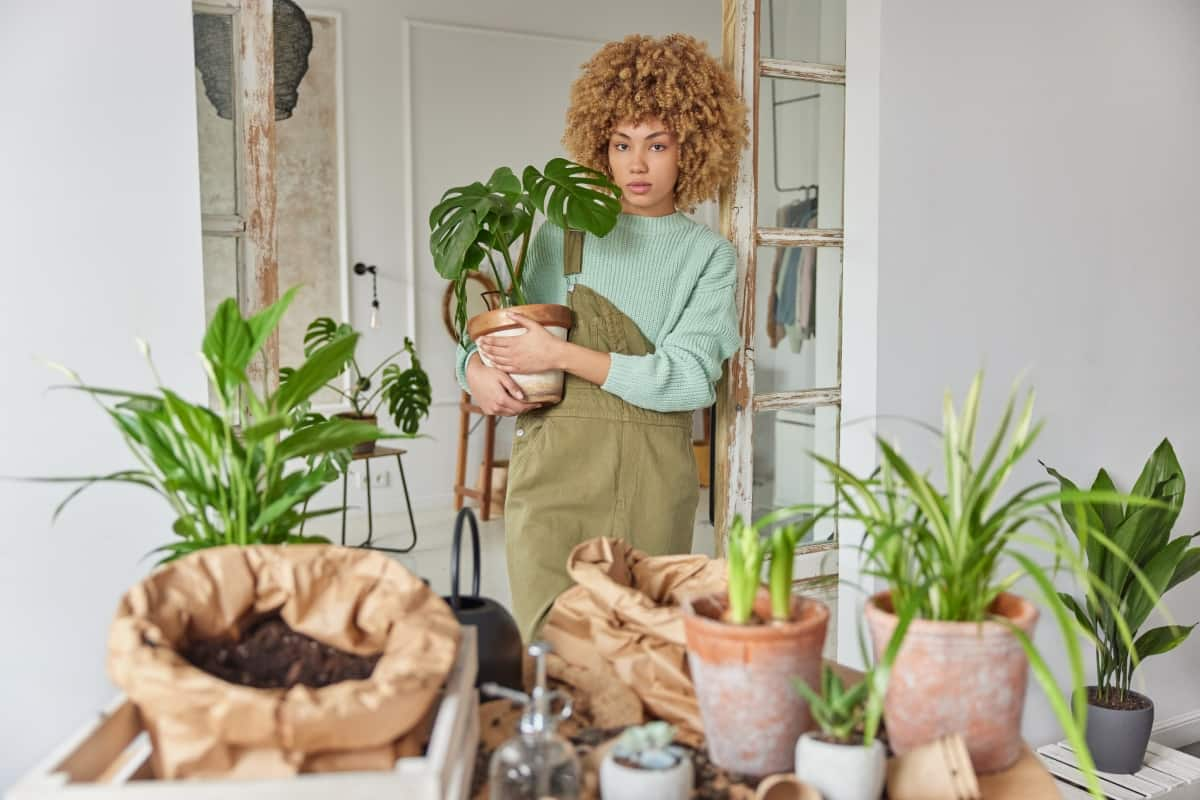Achieving lush, bushy houseplants is a rewarding endeavor for any indoor gardener. A flourishing indoor jungle enhances aesthetic appeal and also contributes to a healthier living climate. To unlock the secrets of abundant foliage, this guide outlines ten effective strategies for promoting faster and bigger growth in your houseplants. From optimizing light exposure to mastering watering techniques, these insights will empower you to cultivate vibrant greenery within your home.

How to Make Houseplants Bushy
Provide Adequate Light for Optimal Growth
Light is the lifeblood of plant growth, and ensuring your houseplants receive the right amount is paramount. Different species have varying light requirements, so familiarize yourself with your plants’ needs. Place light-hungry varieties near south-facing windows, while low-light plants thrive in north-facing locations. Supplemental lighting, like fluorescent or LED grow lights, can bridge gaps in natural light.
Rotate your plant’s containers regularly to ensure all sides receive equal light exposure. Keep an eye on signs of light stress, like stretched or yellowing foliage, and adjust placement accordingly. Striking the right balance between light intensity and duration will create an environment conducive to robust, bushy growth, transforming your indoor space into a flourishing haven of greenery.
Proper Watering Techniques for Bushy Growth
Watering is a delicate art that significantly influences the business of your houseplants. Overwatering leads to root rot, stunted growth, and other issues, while underwatering may cause wilting and leaf drop. Understand your plant’s moisture needs by researching its native habitat and growth patterns. Use well-draining soil to prevent soggy roots.
Water your plants thoroughly, allowing excess water to drain out, and then wait until the top soil is dry before watering again. Consider the season and adjust your watering frequency accordingly, as plants have different requirements in their active growing phase versus dormancy. Implementing a consistent watering routine tailored to your specific plant types will foster the lush, bushy growth you desire.
Choose the Right Soil Mix for Bushy Houseplants
An ideal mix provides the necessary nutrients, aeration, and drainage to support robust growth. Opt for a high-quality potting mix specifically formulated for indoor plants, as garden soil can compact and hinder root development. A well-balanced soil mix typically includes a combination of peat moss, perlite, and vermiculite.
Peat moss retains moisture and promotes aeration, while perlite and vermiculite enhance drainage and prevent soil compaction. Collectively, these components create an environment conducive to root health and nutrient absorption. Consider the specific requirements of your plants; some may benefit from additional amendments.
In case you missed it: How to Get Rid of Houseplant Pests with Homemade Sprays: DIY Guide

For example, adding organic matter like compost or well-aged manure can enrich the soil with essential nutrients. Ensure the mix is pH-balanced, as different plants thrive in varying pH ranges. Regularly repotting your houseplants allows you to refresh the soil, preventing nutrient depletion and compacting. When repotting, gently loosen the roots and provide fresh, nutrient-rich soil.
Prune and Pinch for Bushier Foliage
Regularly remove dead or yellowing leaves to redirect the plant’s energy toward new growth. Pinching involves gently squeezing or snipping off the tips of young shoots, promoting the emergence of side shoots and a denser canopy. This process stimulates branching, resulting in a fuller, more compact plant. Be attentive to the natural growth patterns of your specific plant species, and prune accordingly to maintain a balanced and lush appearance. Embrace these practices during the active growing season for optimal results, fostering a vibrant and bushy indoor garden.
Fertilize Houseplants to Encourage Business
Strategic fertilization is key to promoting bushy growth in houseplants. Choose a balanced, water-soluble fertilizer with a formulation suited to your plant’s needs. During the growing season, apply the fertilizer at half the recommended strength every 4-6 weeks to provide a steady supply of nutrients. Avoid over-fertilizing, as this leads to salt buildup and damage to roots.
Also, consider using a fertilizer higher in phosphorus, which supports root development and flowering. Be mindful of seasonal changes, adjusting your fertilization routine during periods of dormancy. This nutrient-rich approach ensures your houseplants have the resources they need to thrive, resulting in lush, bushy foliage that enhances the beauty of your indoor space.
Use Plant Supports to Promote Bushy Growth
Employing plant support is a practical strategy for promoting bushy growth in houseplants. As plants grow, they may become top-heavy or develop a sprawling habit. Staking or providing support helps maintain an upright form and encourages lateral branching. Use bamboo stakes, rings, or custom-made supports to prop up branches, preventing them from drooping and promoting a more compact shape.
This method is particularly beneficial for tall or vining plants. As your houseplants grow, periodically adjust or add supports to accommodate their changing structure. By implementing plant supports, you guide the growth of your plants, fostering a bushier appearance and ensuring that they maintain an attractive and well-balanced form throughout their development.
Control Pests and Diseases for Healthy Foliage
Maintaining healthy foliage in houseplants requires vigilant pest and disease management. Regularly monitor leaves for signs of pests such as spider mites, aphids, or scale insects. Treat infestations promptly with natural or chemical solutions, ensuring to follow recommended guidelines. Isolate-affected plants to prevent the spread of pests.
In case you missed it: Best 10 Non-toxic Houseplants for Cats: Cat Friendly and Pet-safe Indoor Plants

Provide proper ventilation to minimize conditions conducive to fungal diseases. Water plants at the base to avoid fungal issues and remove any infected leaves promptly. A proactive approach to control pest and disease control safeguards the overall health of your houseplants, fostering the lush and vibrant foliage you desire.
Repot Houseplants for Increased Business
As plants outgrow their containers, their root systems may become cramped, hindering growth. Choose a slightly larger pot with fresh, nutrient-rich soil when repotting. Gently tease out the roots to encourage branching and distribute them evenly. Trim any excessively long or damaged roots.
Repotting not only provides additional space for roots to expand but also refreshes the soil, replenishing essential nutrients. This process stimulates new growth and contributes to a fuller, bushier appearance. Aim to repot every 1-2 years, especially for fast-growing plants, to maintain optimal health and promote lush foliage in your indoor garden.
Propagate Houseplants to Create Fuller Displays
Propagation is a valuable technique for creating fuller displays of houseplants. Utilize methods like stem cuttings, division, or offshoots to generate new plants from existing ones. This not only increases the number of plants in your collection but also encourages bushier growth. When propagating through cuttings, select healthy stems with several nodes, remove lower leaves, and root them in water or a suitable propagation medium.
As these cuttings develop into new plants, the original plant often responds by producing more lateral shoots, resulting in a denser and fuller appearance. Embracing propagation as part of your indoor gardening routine allows you to cultivate an abundant and lush assortment of houseplants, enhancing the visual appeal of your living space.
Temperature and Humidity Considerations for Bushy Growth
Temperature and humidity play pivotal roles in fostering bushy growth in houseplants. Most indoor plants thrive in temperatures between 18-24°C during the day and slightly cooler at night. Avoid drastic temperature fluctuations, as they can stress plants and impede growth. Also, maintaining optimal humidity levels is crucial, especially for tropical plants.
In case you missed it: DIY Horticulture Oil Spray for Houseplant Pests: Homemade Natural, Organic Bug Control Recipe

Use humidity trays, misting, or a humidifier to create a humid microclimate. Adequate humidity encourages vigorous growth, preventing issues like dry leaf edges. Tailoring your indoor environment to suit your plants’ temperature and humidity preferences ensures they flourish with lush, bushy foliage, transforming your living space into a thriving indoor garden.
Conclusion
In cultivating bushy houseplants, these ten strategies serve as a comprehensive guide to fostering faster and bigger growth. Each aspect contributes to a thriving indoor garden. By embracing these practices, you not only enhance the aesthetic appeal of your living space but also nurture a lush, green haven that brings nature’s vitality indoors. Happy gardening!
- Feed Your Flock for Less: Top 10 Tips to Save on Chicken Feed
- Ultimate Guide to Ossabaw Island Hog: Breeding, Raising, Diet, and Care
- Hatching Answers: The Top 10 Reasons Your Chickens Aren’t Laying Eggs
- Eggs and Economics: Breaking Down the Cost of Raising Backyard Chickens
- Defend Your Greens: Proven Methods to Keep Iguanas Out of Your Garden
- Ultimate Guide to Cinnamon Queen Chicken: A Comprehensive Guide for Beginners
- Ultimate Guide to California Tan Chicken: Breeding, Raising, Diet, Egg-Production and Care
- Ultimate Guide to Marsh Daisy Chicken: Breeding, Raising, Diet, and Care
- 10 Types of Chicken Farming Businesses You Can Start for Profits